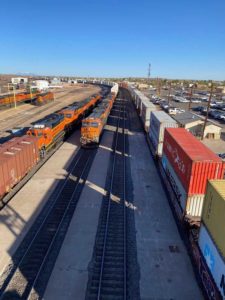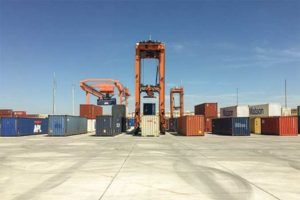
“As our volume fluctuates, our job is basically to match our resources with that demand,” Farmer says, in terms of the railroad’s employment levels and the size of its active locomotive and railcar fleets.
“Obviously volume dictates how we manage those resources and how we work to handle the demand that’s out there,” Farmer said on an intermodal webcast this week. “With that said … regardless of what we see on volumes and the economy, we continue to invest in our infrastructure. We recognize that if you forego investment in your infrastructure it takes many, many years to catch up. It becomes a safety issue, it becomes a capacity and velocity issue for our customers.”
Over its 25 years, BNSF has continued to invest in its network even during downturns. “This year is no different,” Farmer says. This year BNSF will spend nearly $2.6 billion to maintain its system, including 11,000 miles of track surfacing work, replacement of 489 miles of rail and nearly 2.7 million ties.
“We think those things are critical to protect the velocity and safety of our network,” she says.
Meanwhile, BNSF is spending $581 million this year to forge ahead with multiyear capacity expansion projects that are part of a five-year rolling plan. “Although volumes were down, we had several significant capacity expansion projects that we were already in process on that we continued to work through during the back part of last year into 2020 and we will continue to work through into 2021,” Farmer says.
In April a fourth main track was placed in service at Winslow, Ariz., the final crew change point on the Southern Transcon to gain additional capacity that allows faster trains to leap ahead of slower traffic. “We really think that this is going to be a really big capacity and velocity enabler for us on the Southern Transcon,” Farmer says.
A multiyear expansion project at BNSF’s Dallas/Fort Worth area intermodal terminal at Alliance, Texas, is nearing completion and will give the fast-growing facility the capacity for one million lifts per year.
A year ago BNSF opened a small intermodal terminal in Barstow, Calif., that has 6,600 feet of track and 640 parking spaces. “I can tell you we are glad that we have Barstow with the volumes we are handling today,” Farmer says. Domestic intermodal volume has surged 30% in Southern California since late June.
BNSF is adding a second single-track bridge across Lake Pend Oreille in Sandpoint, Idaho, to clear the last significant bottleneck on its Northern Transcon. The Sandpoint Junction project, which will be complete in a couple of years, aims to reduce congestion at BNSF’s junction with Montana Rail Link.
“This will really facilitate greater throughput and velocity into and out of the Pacific Northwest, both across our Northern Transcon and connecting with the Montana Rail Link,” Farmer says.
BNSF also is working to improve efficiency and capacity at its existing intermodal terminals through several pilot projects that aim to streamline the gate process and automate terminals.
The railroad is encouraged by the use of an autonomous autostrad crane at its Logistics Park Kansas City, which has improved efficiency and velocity while providing safety benefits, Farmer says. The technology, which is common at container ports around the globe, may allow BNSF to eliminate hostlers at its intermodal terminals.
BNSF also is experimenting with autonomous yard trucks at its terminal in Oakland, Calif., and remote-control crane operations at Logistics Park Chicago.
“We’re incredibly excited about the automation efforts,” Farmer says. “We think that this is really the future of automation inside of intermodal facilities.”
Farmer was asked if it was an advantage for BNSF to be a part of Berkshire Hathaway rather than a standalone public company that must answer to Wall Street every quarter.
“It is great being a part of Berkshire, and we do believe that we can continue to look beyond the next quarter if you will,” Farmer says, noting that Berkshire CEO Warren Buffett has encouraged a long-term outlook.
But BNSF took a long-term view prior to being acquired in 2010, Farmer says, noting that the backbone of the railroad’s intermodal network was in place before the company was taken private.
Farmer spoke on a webcast with the Intermodal Association of North America on Wednesday.














